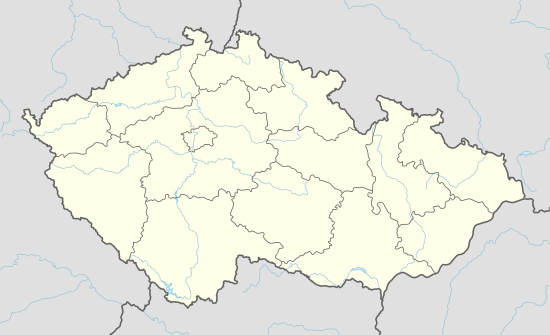Bukovec (Frýdek-Místek District)
| Bukovec Bukowiec | |||
|---|---|---|---|
| Village | |||
|
Olza River in the village | |||
| |||
 Location in the Czech Republic | |||
| Coordinates: 49°32′58″N 18°49′25″E / 49.54944°N 18.82361°ECoordinates: 49°32′58″N 18°49′25″E / 49.54944°N 18.82361°E | |||
| Country | Czech Republic | ||
| Region | Moravian-Silesian | ||
| District | Frýdek-Místek | ||
| Established | 1353 | ||
| Government | |||
| • Mayor | Monika Czepczorová | ||
| Area | |||
| • Total | 17.06 km2 (6.59 sq mi) | ||
| Elevation | 455 m (1,493 ft) | ||
| Population (2006) | |||
| • Total | 1,368 | ||
| • Density | 80/km2 (210/sq mi) | ||
| Postal code | 739 84, 739 85 | ||
| Website |
www | ||
![]() Bukovec (Polish: Bukowiec , German: Bukowetz) is a village in Frýdek-Místek District, Moravian-Silesian Region of the Czech Republic. It has 1,356 inhabitants (2001 census), 33.6% of the population are the Poles and 87.3% are Roman Catholics.[1] It is the easternmost village of the country and the first village in the Czech Republic through which the Olza River flows. It lies in the historical region of Cieszyn Silesia.
Bukovec (Polish: Bukowiec , German: Bukowetz) is a village in Frýdek-Místek District, Moravian-Silesian Region of the Czech Republic. It has 1,356 inhabitants (2001 census), 33.6% of the population are the Poles and 87.3% are Roman Catholics.[1] It is the easternmost village of the country and the first village in the Czech Republic through which the Olza River flows. It lies in the historical region of Cieszyn Silesia.
History
The village was established by Kazimierz, Duke of Cieszyn in 1353. The name of the village is derived from beech forests that grew there - buk is a Slavic root for beech. The first settlers lived mainly off the logging of local beech forests. After 200 years, the village gained a farming-pasture character. Pastures were established on nearby hills. The number of inhabitants rose very slowly. By 1647, only 20 people lived there. Settlers had many children and soon number of inhabitants rose. They lived in wooden houses.
Since the 18th century, villagers lived mainly off the transport of salt from Wieliczka to Jabłonków, farming, transport of wood and smithing. Later they worked in coal mining and metallurgy. From the interwar period until after World War II, smuggling was widespread, as in other villages near the borders.
After Revolutions of 1848 in the Austrian Empire a modern municipal division was introduced in the re-established Austrian Silesia. The village as a municipality was subscribed to the political district of Cieszyn and the legal district of Jablunkov. According to the censuses conducted in 1880, 1890, 1900 and 1910 the population of the municipality grew from 844 in 1880 to 1,071 in 1910 with the majority being native Polish-speakers (between 97.7% and 99.9%) accompanied by German-speaking (at most 19 or 2% in 1890) and Czech-speaking people (at most 3 or 0.3% in 1890). In terms of religion in 1910 the majority were Roman Catholics (92.7%), followed by Protestants (7.3%).[2] The village was also traditionally inhabited by Silesian Gorals, speaking Jablunkov dialect.
After World War I, fall of Austria-Hungary, Polish–Czechoslovak War and the division of Cieszyn Silesia in 1920, it became a part of Czechoslovakia. Following the Munich Agreement, in October 1938 together with the Zaolzie region it was annexed by Poland, administratively adjoined to Cieszyn County of Silesian Voivodeship.[3] It was then annexed by Nazi Germany at the beginning of World War II. After the war it was restored to Czechoslovakia.
From 1975 to 1990 the village was administratively a part of Jablunkov.
The village has been traditionally Roman Catholic. The first church was built in June 1939. Bukovec is still locally known for its relatively slow pace of lifestyle. Villagers keep all cultural and religious traditions. Many of the traditional old wooden houses can still be seen.
Footnotes
- ↑ "2001 census data". Czech Statistical Office.
- ↑ Piątkowski, Kazimierz (1918). Stosunki narodowościowe w Księstwie Cieszyńskiem (in Polish). Cieszyn: Macierz Szkolna Księstwa Cieszyńskiego. pp. 266, 284.
- ↑ "Ustawa z dnia 27 października 1938 r. o podziale administracyjnym i tymczasowej organizacji administracji na obszarze Ziem Odzyskanych Śląska Cieszyńskiego". Dziennik Ustaw Śląskich (in Polish). Katowice. nr 18/1938, poz. 35. 31 October 1938. Retrieved 1 July 2014.
References
- Cicha, Irena; Jaworski, Kazimierz; Ondraszek, Bronisław; Stalmach, Barbara; Stalmach, Jan (2000). Olza od pramene po ujście. Český Těšín: Region Silesia. ISBN 80-238-6081-X.
External links
| Wikimedia Commons has media related to Bukovec (Frýdek-Místek District). |
- (Czech) Official website




